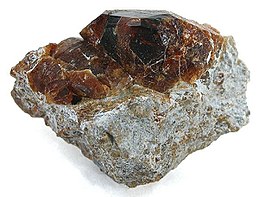| Chondrodite | |
|---|---|
 | |
| General | |
| Category | Nesosilicates |
| Formula (repeating unit) | Mg 5(SiO 4) 2F 2 |
| IMA symbol | Chn[1] |
| Strunz classification | 9.AF.45 (10th edition) 8/B.04-20 (8th edition) |
| Dana classification | 52.3.2b.2 |
| Crystal system | Monoclinic |
| Crystal class | Prismatic (2/m) (same H-M symbol) |
| Space group | P21/a |
| Identification | |
| Formula mass | 351.6 g/mol |
| Color | Yellow, orange, red or brown, rarely colorless |
| Crystal habit | Typically anhedral masses or grains, or as plates flattened on {010}, {001} or {100}.[2] |
| Twinning | Simple or multiple twinning common on {001}, also reported on {105} and {305}.[2] |
| Cleavage | Poor to good on (001) |
| Fracture | Conchoidal to uneven |
| Tenacity | Brittle |
| Mohs scale hardness | 6 to 6.5 |
| Luster | Vitreous to greasy |
| Streak | Grey or yellow |
| Diaphaneity | Translucent |
| Specific gravity | 3.1 to 3.26 |
| Optical properties | Biaxial(+) |
| Refractive index | nα = 1.592 – 1.643, nβ = 1.602 – 1.655, nγ = 1.619 – 1.675, |
| Birefringence | 0.027 – 0.032 |
| Pleochroism | X golden yellow to orange, Y and Z light yellow to almost colorless[3] |
| Solubility | Soluble in HCl and H2SO4 |
| Other characteristics | Some specimens fluoresce orange yellow under shortwave and orange under longwave UV. Not radioactive. |
| References | [4][5][6][7][8] |
Chondrodite is a nesosilicate mineral with formula (Mg,Fe)
5(SiO
4)
2(F,OH,O)
2. Although it is a fairly rare mineral, it is the most frequently encountered member of the humite group of minerals. It is formed in hydrothermal deposits from locally metamorphosed dolomite. It is also found associated with skarn and serpentinite.
It was discovered in 1817 at Pargas in Finland, and named from the Greek for "granule", which is a common habit for this mineral.[9]
- ^ Warr, L.N. (2021). "IMA–CNMNC approved mineral symbols". Mineralogical Magazine. 85 (3): 291–320. Bibcode:2021MinM...85..291W. doi:10.1180/mgm.2021.43. S2CID 235729616.
- ^ a b Cite error: The named reference
P&Gwas invoked but never defined (see the help page). - ^ European Journal of Mineralogy (2002) 14: 1027-1032
- ^ "Chondrodite". Mineralienatlas.
- ^ Cite error: The named reference
Danawas invoked but never defined (see the help page). - ^ "Chondrodite". Mindat.
- ^ "Chondrodite Mineral Data". WebMineral.
- ^ "Chondrodite" (PDF). RRUFF. Retrieved 14 June 2024.
- ^ Hintze, C. (31 December 1897). "Humitgruppe". Silicate und Titanate: 370–406. doi:10.1515/9783112361047-011. ISBN 9783112361047.
The usually granular occurrence in the limestone of Pargas in Finland was described by D'OHSSON (Vet. Akad. Handl. Stockh. 1817, 206) after χονδρος "granule" as chondrodite